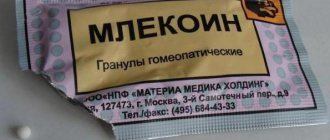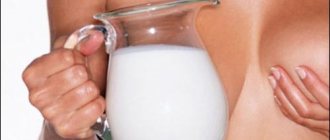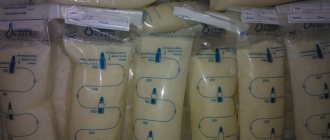Basic Rules
The shelf life of milk depends on the processing method, the container used, the delivery method and the conditions of the store where you purchased it. It would also be a good idea to follow the recommendations below.
- Buy milk in small quantities. After opening the package, it should be consumed within 2-3 days. Therefore, it is better to make purchases more often, but at the same time be confident in the quality of the product.
- Keep milk away from foods with strong flavors as it easily absorbs odors.
- Do not pour unused milk back into the original container.
- Make sure that the place where the product is stored is dark and the air temperature in it does not exceed +2 ... +5 ° C.
- You can extend the shelf life of pasteurized milk by pouring it into a glass jar after opening the package.
- Be sure to keep milk purchased at the market in sterile glass jars with a tight-fitting lid. Boil goat milk first.
Deadlines
The shelf life of the product depends on the type of heat treatment. It is better to leave fresh homemade milk in an enamel or glass container for a maximum of 2 days. If you boil it, the shelf life will increase to 7 days. Pasteurized milk in an airtight container can remain in the refrigerator until the final date specified by the manufacturer. After opening the package, this product must be consumed within 3 days.
It is recommended to store fresh homemade milk in glass or enamel containers for no more than 2 days.
By purchasing sterilized milk, you can be sure that it will be stored in sealed packaging without loss of quality for up to 6 months. Once opened, it can be kept in the refrigerator for no more than 10 days.
The shelf life of condensed milk ranges from 6 months to 1 year. It is recommended to wrap the opened jar in a plastic bag and consume it within 2 weeks. Powdered milk can be stored for 8 to 10 months. If it is low-fat, then the shelf life can reach 3 years. It should be remembered that powdered milk is sensitive to high humidity and temperature changes.
Storing expressed breast milk
Containers for storing expressed breast milk should hold from 70 to 120 grams of milk, which is the average volume required for one feeding of the baby, so as not to constantly open sterile containers, as this will spoil faster. This way you will be sure that the rest of the milk is safe and sound. It is important to label the container of breast milk so that you know the exact time of expression and storage duration.
Rules for storing breast milk
The shelf life of expressed breast milk at room temperature (23-25 C) is no more than four hours, at a temperature from 19 to 22 C - no longer than 10 hours, and from 15 to 18 C - no more than a day, then the milk must be poured out.
Storing milk in a cooler bag depends on the quality and ability to keep the temperature, but not more than 24 hours.
Milk is stored in special sterile dense plastic or glass containers or special breast milk freezing bags. It is not recommended to freeze breast milk in disposable bottle bags, and the new portion must be refrigerated before adding a new portion to already frozen milk. You can add a new portion of chilled milk
mint with another portion of frozen or cold milk, provided that the amount of milk added is small enough that it cannot defrost the previously frozen portion. But it is better to freeze breast milk in a small volume (from 60 to 130 ml).
Expressed milk, which must be given to the baby within 5 days after expressing, is best stored in the refrigerator, without freezing, so that the vitamins and immune factors contained in it are better preserved and do not even partially lose their properties, unlike frozen milk. But if you need to store milk for more than 8 days, it is better to freeze the product.
Thawed milk can be left in the refrigerator for 24 hours, but this portion cannot be re-frozen.
Storing breast milk in the refrigerator
In a refrigerator with a temperature range of 0 to -4 degrees, containers with expressed breast milk can be stored for no more than 4 days, and at a temperature of -5 (-6 C) - no more than 5 days.
Storing breast milk in the freezer
The shelf life of expressed breast milk depends on the type of freezer, how often it is opened, where the milk container is stored and its temperature. In a freezer with a temperature of -20 degrees, if the refrigerator is not self-defrosting, the shelf life is up to 6 months, in a freezer with a separate shelf - no more than 3 months. If the freezer compartment has a separate door, the shelf life of frozen breast milk is no more than 3-4 months, due to the fact that the temperature can vary due to frequent opening of the door.
Frozen milk on a freezer shelf inside a refrigerator that does not have a separate door should be stored for no more than two weeks. When storing expressed milk in a separate stationary deep-frozen freezer with a constant temperature of -19 C, the shelf life can be 6 months or more.
Shelf life of breast milk
- The shelf life of expressed breast milk depends on the temperature:
- outside the refrigerator: indoors at a temperature of 23-25 C - no more than four hours, from 19 to 22 C - 10 hours, and from 15 to 18 C - no more than a day;
- in a refrigerator bag - no more than a day;
- in the refrigerator - from four to five days (depending on the constant temperature inside the refrigerator);
- in the freezer - from three to six months.
Selection of containers
Now on store shelves you can buy milk in a variety of packaging: from glass bottles to tetra packs. To maximize shelf life, milk in plastic or paper containers is recommended to be poured into sterile glass containers. The only exception is the ultra-pasteurized product. It can be stored in any packaging.
From glass
Glass storage containers are considered the most expensive. The high cost is due to their high quality.
In addition to the cost, they have some other disadvantages:
- Used only for short-term storage of milk.
- Requires sterilization before each use.
- Some milk fat remains on the walls of glass containers, which reduces the nutritional value of milk.
- They require careful handling so as not to break.
In addition to quality, jars have some other advantages:
- Withstands high and low temperatures.
- Easy and quick to clean.
- Do not turn yellow from long-term use.
- They do not emit harmful substances.
The cost of plastic containers is much lower than glass.
Made of polycarbonate (marked “O” or “Other”)
Advantages:
- Withstand temperature changes (do not deform or form cracks).

Milk in the refrigerator
Flaws:
- Low-quality polycarbonate can emit toxic substances; it is necessary to track the certificate.
- Transparent walls allow light to pass through, which leads to rapid breakdown of nutrients.
Made from polypropylene
If you choose between food-grade plastic utensils, it is better to choose polypropylene ones (marked “PP”).
Advantages:
- They have very high quality and safest material.
- Can withstand any temperature, up to +140 degrees.
- They do not emit toxic substances.
- Do not affect the quality and taste of milk.
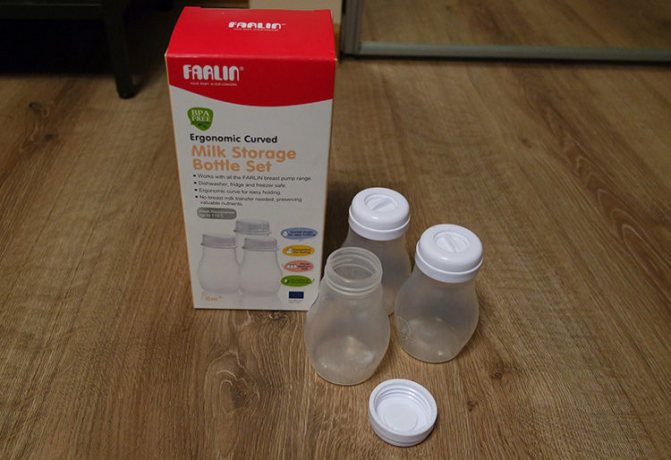
Polypropylene bottles for storing and freezing breast milk
Minuses:
- Short service life;
- When in contact with sugar, fats and alcohol, they can release toxic substances (formaldehyde, phenol).
Mostly you need to buy milk containers made of special plastic - cloudy and quite soft. It doesn’t look so attractive, but it definitely won’t harm the child’s health. It is better to use such dishes 4-5 times if cracks or scratches do not appear on the inside.
If there is no special packaging or there is nowhere to buy it, then it is possible to store it not in a special container. The main thing is that it does not contain bisphenol A (BPA, 3, 7). This element in the composition of the container causes disruption of the endocrine system. Breast milk should not be stored in formula inserts because they will leak and destroy the components of breast milk. It is important to write on the container what date the milk was expressed. The container with milk must be tightly closed.
Types of milk storage containers
Containers intended for breast milk must meet sanitary and epidemiological standards and ensure the safest possible storage of a valuable product. Conventionally, all produced options can be divided into two large groups - containers and disposable bags, each of which has its own advantages.
Containers
Solid reusable containers for milk are popular due to their practicality - once you have purchased the required number of containers, you no longer have to worry about what to store and freeze food that is valuable to your baby. Certified products are safe for children and can withstand temperature changes over a wide range. The most popular brands of containers are:
- Philips Avent Via. Sold in 5 and 20 pieces per package (10 with a capacity of 180 ml and 10 with a capacity of 240 ml). The vessels are sterilely packaged, and before the first use they do not need to be specially prepared; the material is plastic without harmful additives. They are subsequently suitable for steam sterilization. They are equipped with tightly screwed lids, which protect against spills and foreign liquids or odors getting into the milk. They have a flat bottom, so they stack stably on top of each other and fit compactly in the refrigerator or freezer. The containers are compatible with breast pumps from this manufacturer, so you can express milk directly into the storage container. The approximate cost of one container is 120 rubles;
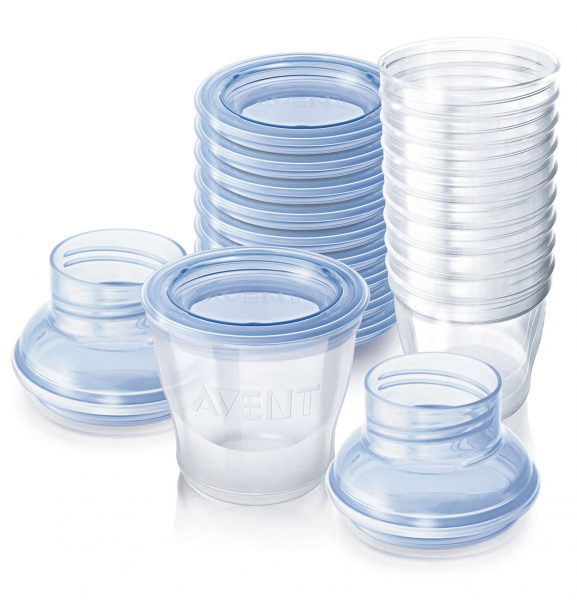
Philips Avent Via containers are equipped with lids and attachments for attaching to a breast pump
- Medela bottles, capacity 150 ml and 250 ml. Swiss milk containers are safe, made of medical polypropylene, do not contain bisphenol A and do not harm the baby’s health. For convenience, they can be attached directly to the breast pump. The wide neck makes it easy to collect and pour out the milk, and the lid screws on tightly to prevent spillage. The approximate price of one piece is 250 rubles;
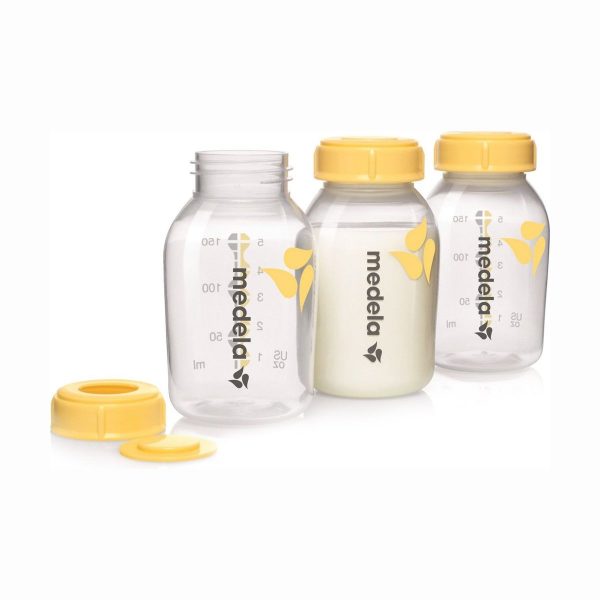
Medela bottles are made from safe polypropylene and can be stored in the refrigerator or freezer
- Canpol Babies containers of 180 ml. Made from polypropylene, safe for children. The containers can be used for storing and freezing breast milk; they are tightly closed with the lids included in the kit. The wide neck makes filling easy, and the shape of the bottom and lid allows you to place the vessels in the refrigerator, stacking them on top of each other. The approximate cost of one container from the set is 120 rubles.
Canpol Babies containers are suitable for reusable use and are available with a capacity of 180 ml.
In general, the use of containers is convenient and safe if all rules are followed, but there are also disadvantages. So, if you need to freeze milk in large quantities and store it for a long time, you will need to purchase a large number of vessels at once, and this will not be cheap. Although many manufacturers create conveniently shaped containers for compact placement, they still take up more space than bags.
For me, Avent containers have become indispensable, because... I was faced with such an unpleasant procedure as constantly pumping and feeding my baby through a bottle. There were always not enough bottles (and I wanted to at least not get up at night and wash them), so I decided to buy containers.
Diana
before sending it into freezer bags and very rarely with a pacifier when you need to feed the baby without me. Realistically speaking, I am very pleased with the Medela bottle, despite the disadvantages: 1. After long-term use, the scale on the bottle is erased; 2. Since the plastic is of high quality and quite soft, such a bottle cannot be washed with a brush, I cut off a soft sponge and rinse it with it. Minor inconvenience.
Flora
Packages
Sterile breast milk bags are very popular today due to their advantages:
- milk does not require processing after opening the package;
- the containers are soft and compact, they save space in the refrigerator or freezer;
- they can be attached directly to the breast pump, which reduces the risk of bacteria and foreign odors;
- They are disposable, you don’t need to wash anything after use, just throw it away.
Let's look at the main product manufacturers:
- Lansinoh. Available in boxes of 25, 50 or 100 pieces. The capacity of one bag is 180 ml, it has a scale in milliliters, allowing you to navigate the amount of contents, and in the upper part there is a place for marks with a marker. The bags are sterile and equipped with a double zip-lock fastener, which allows for hermetically sealed closure, removing excess air, which reduces the likelihood of milk spoilage. Made from special medical polyethylene without harmful components. There is a special insert on the bottom that ensures the stability of the disposable container in a vertical position. The cost is average for this category of goods, one package will cost 18–20 rubles;
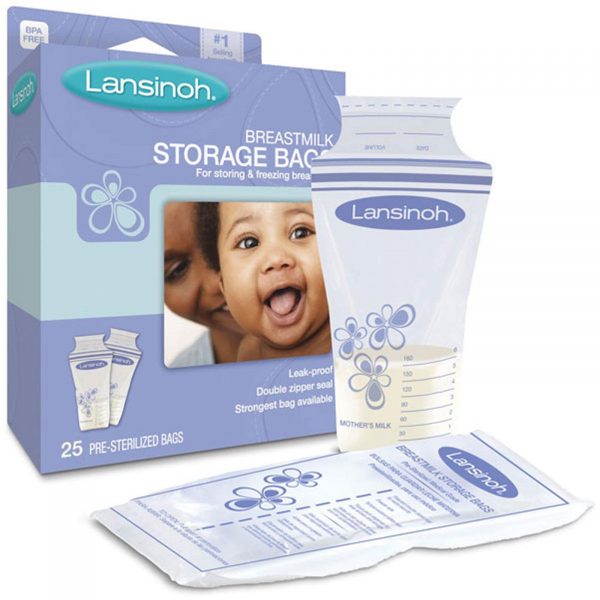
Lansinoh milk cartons with a capacity of 180 ml per pack of 25 pieces
- Canpol babies. Packages with a capacity of 150 ml are sold in a pack of 20 pieces and are equipped with a similar number of self-adhesive labels on which you can make notes. Made from safe, dense raw materials, sterilized, which allows you to maintain the freshness and quality of the contents. The durable clasp and bottom shape allows you to store bags vertically or horizontally. The hole for pouring milk is the width of the entire package, and to open and remove the contents you need to cut or tear along the line marked at the top. The price per piece is comparable to other products in the group;
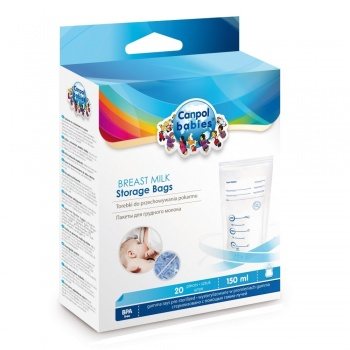
Bags for storing and freezing milk Canpol babies are available with a capacity of 150 ml and have a convenient shape for storage
- Tommee Tippee. The package contains 36 bags with a capacity of 350 ml, they are sterilized and can be used immediately for storing milk without prior preparation. The wall material does not contain toxic components and is safe for children. The wide neck makes it easy to fill the container, and the tight double clasp protects against leakage. There is a sticker at the top of the package to record the necessary information about the contents. The price per piece is approximately 17–18 rubles, typical for this segment;
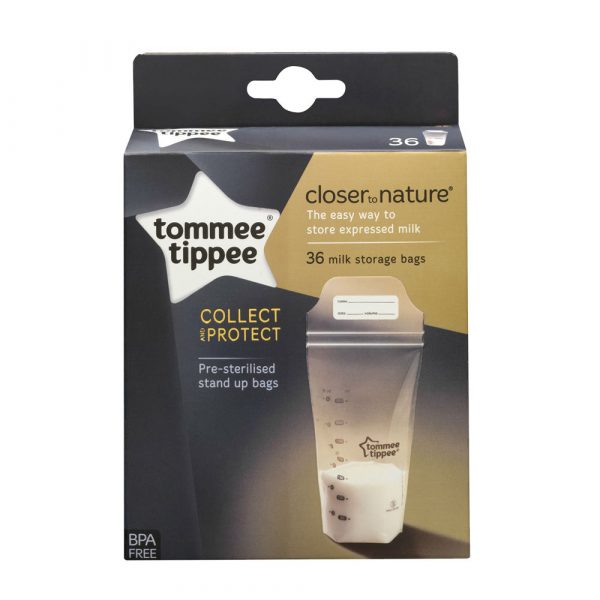
Tommee Tippee bags are distinguished by their large volumes (350 ml), but have an average price - Philips Avent. The package contains 25 bags of 180 ml each, manufactured in Great Britain. The bags have a warranty seal, which provides additional product protection and safety of first use. The eco-passport confirms that the containers are made of safe and environmentally friendly material without harmful additives. Sterilization is carried out by the electron beam method, and the bags do not require any preparation for their intended use. The walls are double-layered, all seams are reinforced, which makes the bags durable both for storage at different temperatures and for transportation. For the convenience of pouring milk, the manufacturer has equipped its products with a bottom for a stable vertical position and a wide neck opening. After defrosting, pouring the milk into a bottle, simply cut off the bottom of the package;
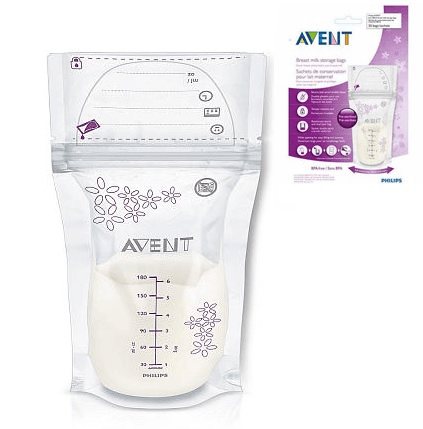
Philips Avent manufactured in the UK have a standard capacity of 180 ml, and are equipped with a tamper-evident seal to ensure safety
- Medela Pump and Save. In a package - 2 or 20 pieces of 150 ml. The bags are equipped with self-adhesive tape, which allows you to attach them directly to the breast pump, providing additional protection for your milk. The walls are double-layered, allowing you to store food for your baby in the freezer for a long time, and the material itself, in addition to safety, helps preserve the beneficial properties of the contents, keeping air and moisture out. The inner layer is made of polyethylene, the outer layer is made of polyester, and the bags are tightly sealed on the sides to prevent leakage. The products are the most expensive of all those reviewed; the average cost of one package is 3 times higher than the price of other manufacturers.
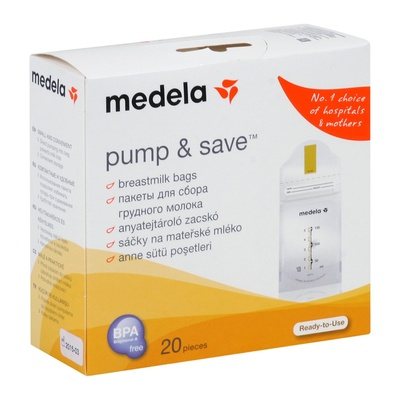
The bags also have disadvantages associated with the basic principles on which their operation is based. So, the main disadvantage is the impossibility of reuse. Such containers are exclusively disposable, and if you need to constantly store milk, the cost of purchasing them will be high.
I bought Lansinoh packages as the cheapest. I was immediately struck by the strong plastic smell when opening the package. The polyethylene was thin and strange to the touch, and the seams were poorly sealed, uneven and unreliable. It froze fine. I was pleased with the convenient strip for signing the date of freezing. But when defrosting, the milk separated and acquired a strong disgusting plastic smell and a bitter plastic taste. Naturally, I decided that it was unsafe and did not take risks.
Tosha
Frozen milk looks compact, no leaks were noticed, not a single Philips Avent package was torn or cracked. The milk retained its quality after defrosting. I recommend this thing, because milk can burn out at any moment, and this way you are reliably on the safe side. The only negative is it's expensive.
Angelica
When I was preparing for the birth of my son, my nieces, who by that time had fattened their children, gave a lot. One of their gifts was Medela Pump and Save Sterile Breast Milk Storage Bags since everyone knew I would be breastfeeding my son. At first I didn’t appreciate the charm of these bags; my son was hospitalized and all the milk that I expressed was taken to the hospital in containers; bags were not allowed. Having been discharged home with my son, I appreciated the packages. I decided to keep the milk for future use and expressed about five bags of milk, they helped me out from time to time. The lock on the bags is excellent, I stored the bags in the freezer lying down, and there was never a single time when the bags leaked.
Masha
Breast milk storage containers
Store expressed breast milk in special containers made of food-grade plastic or glass containers, hermetically sealed, which are produced by companies that produce accessories for breastfeeding. They are compact and easy to use, convenient and do not require special treatment, and milk can be expressed directly into them. For convenience, some types of bags can be attached directly to the breast pump. Various bags and containers are used to store milk. Each type of container for storing expressed milk has certain advantages and disadvantages.
When choosing containers for storing expressed milk, experts recommend:
- First of all, use glass vessels.
- On the second are containers made of polycarbonate (transparent hard plastic).
- On the third are polypropylene opaque plastic vessels.
Containers for storing expressed breast milk, if the baby rarely drinks expressed milk, then the container can be made of any material - both glass and plastic, it is important that all its beneficial substances and immune factors are preserved, so they must be clean, dry and close tightly.
One of the important factors when choosing a container for storing expressed milk is ease of use.
Bottles for storing breast milk
Bottles for breast milk must be purchased at pharmacies - this means that this type of container for collecting and storing expressed milk is of high quality, has passed all tests and is airtight. The products have good recommendations from experts. There are several types of bottles:
- Glassware, which is better for storage, but can be damaged by sudden temperature changes - cracks and damage are possible.
- Plastic bottles are slightly inferior in storage to glassware, but are more practical and resistant to temperature changes.
Breast milk storage containers
Today, the pharmacy chain offers a wide range of different special containers for storing and freezing breast milk. These sterile containers do not require additional processing. Containers for breast milk are special plastic jars that are sealed with a lid. They also have a special graduation, with which you can determine the volume of expressed breast milk (number of milliliters).
The most commonly used containers are the Philips AVENT storage system.
Breast milk storage bags
Breast milk collection bags are sterile plastic containers that are closed with a clasp or tied with strings, with space for recording the date of collection of breast milk and special graduations for collecting breast milk.
Dividing the volume of expressed breast milk.
They take up little space and can be directly connected to breast pumps. Bags intended for storing milk are sold sterilized and can be easily sealed. Long-term storage of frozen breast milk in disposable plastic bags is not recommended.
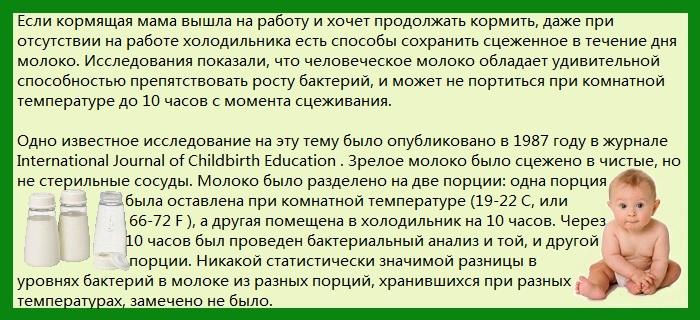
Which one is better to choose?
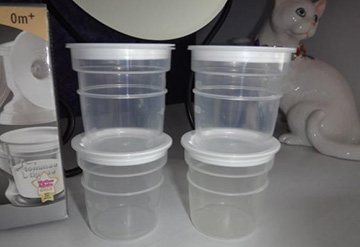
With careful and attentive handling, it is better to purchase a glass container; it will last a long time and will not need to be replaced.
If careful use is difficult to ensure, it is better to take a plastic container and not worry about broken dishes.
You also need to consider the storage period for which you need the container, the amount of milk your baby eats, and whether you plan to buy a breast pump. Milk jars are included with the breast pump, and if not included, you can buy them in the same store as the breast pump. This will make the process of collecting and transfusing breast milk very easy.
Where can I buy?
You can purchase containers for storing breast milk at any children's store, pharmacy, as well as on the websites of manufacturers or suppliers of various brands.
When purchasing, pay attention to:
- ease of use (twist in your hands);
- strength and reliability upon visual inspection;
- absence of cracks, scratches and other defects;
- tightness of the lid.
You should not choose products from China or from dubious manufacturers.
How to Freeze Milk: Containers and Bags for Freezing Breast Milk
In general, there are practically no difficulties in freezing breast milk.
You just need to select a suitable container, process it, express the milk, close it tightly and put it in the freezer.
It would seem that the truth is nothing complicated. But a lot of questions immediately arise. Especially in terms of choosing this very container.
In principle, any container that is hermetically sealed, tolerates freezing well, and is suitable for food products will do.
It should be washed and rinsed thoroughly, then doused with boiling water and allowed to dry.
It is better to give preference to containers specially designed for this purpose. Today, special containers and bags for freezing breast milk are on sale almost everywhere. They are quite easy to process and are hermetically sealed, and, in addition, they have different sizes. This allows you to freeze almost any portion of breast milk.

It is usually recommended to purchase a special container for milk and several freezer bags. The mother expresses into the container during the day, keeping it in the refrigerator, and freezes one or several portions of milk once a day. It is believed that this option is more convenient in everyday life.
Recommendations for feeding expressed breast milk
When stored, breast milk usually separates into layers and the fats (cream) it contains rise to the top. Shake the bottle gently to mix the layers before giving it to your baby. Violent stirring and shaking may destroy some of the nutritional and protective components of breast milk 5 .
When a baby feeds expressed breast milk from a cup or bottle, bacteria from the baby's mouth naturally gets into the milk. Therefore, it is best to pour out all unfinished milk one to two hours after the first feeding. To waste as little expressed milk as possible, it is best to store it in small portions and use only as much as is needed for one feeding 2 .
How to warm up expressed breast milk 2, 3
Healthy full-term infants can be given breast milk at room temperature or warmed to body temperature. Some children care about the temperature of the milk, while others drink milk at any temperature.
- To warm breast milk, place the bottle or bag in a cup, mug or bowl of warm water for a few minutes until the milk warms to body temperature (37°C). You can use a bottle warmer. Do not heat milk above 40°C or microwave it to avoid overheating.
- Gently shake the milk in the bottle or bag to stir in the separated fat (see above). Do not stir or shake the milk too much.
Long-term storage
Please refer to the package instructions for information on how to freeze breast milk. First of all, prepare the freezer compartment: remove foreign products, wash the drawer with baking soda or a special product, and wipe dry. Pour the expressed product into a bag, remove the air, close it with a clasp, and mark the time and date with a marker. Not every mother knows how to freeze milk correctly. The scheme is simple: first you need to cool the milk carton in the refrigerator for 4-5 hours, then put it in the freezer compartment. Breast milk can freeze at a temperature of -0.5°C. Frozen breast milk can be stored in the freezer at -18°C for about a month, at -20°C for 90 days. There are also no difficulties in the question of how to defrost breast milk. The package must first be placed in the refrigerator for 4-5 hours, then heated to +37°C and given to the child in a bottle.
Young parents are often interested in how to properly defrost breast milk. After freezing, the package should not be placed in a microwave oven, boiling water, or bottle warmer. A thawed product should not be re-frozen; adding fresh milk to used milk is also not recommended.


